Throwing and grasping objects (Fine motor)
Developing throwing skills while practicing shape recognition
Instructions

- Draw “targets” with a child on a sidewalk/pavement with chalk
- Draw a large square, circle, triangle, rectangle
- Leave lots of space between these “shape targets”
- Give a child a beanbag and ask him to throw at the targets
- Throw beanbag to land in square
- Throw beanbag to land next to the rectangle
- Throw beanbag to land on a circle, etc.
- See if the child can throw underhand and overhand
* Can make the target shapes indoors with duct tape
Simplify
Adjust the size of targets and distances to throw for the child to be successful. For example, make a very large circle and have the child stand very close with a beanbag to throw at the circle target.
Extend
Encourage the child to throw at a target while throwing under their leg, OR when standing backwards, OR by placing beanbag on the head and tossing at target shape. This can be such a fun and silly learning opportunity.
To add some math skills, place a number on each shape.
Square - 1; Circle - 2; Triangle - 3; Rectangle - 4. Throw the beanbag 5 times and see who can add up the most points.
QUESTIONS FOR CHILD
Can you tell me what sports are played where knowing how to throw is important?
Do you think you are a better artist or athlete?
Materials
- sidewalk/pavement
- chalk
- beanbag (make your own beanbag by putting beans/rice/birdseed into a ziplock sandwich bag that is closed with duct tape and then place in an old sock. Fold the top of the sock over the bag to make a beanbag)
Curriculum Plan Resources
Skills Focus
- Shape - Rectangle
- Color - Orange
- Number - 1-4 Review
- Alphabet - O, U
- Senses - Sight
- Character Trait - Responsibility
- Target Words - Under, Up, Down, Tall
Monthly Proverb
Yiddish- If each person sweeps in front of his own door the whole street is clean
Did You Know?
"The brain builds itself in response to the child’s experiences. Brain circuits that the child uses in daily life are strengthened. Those that the child doesn’t use fade away. "
National Research Council From Neurons to Neighborhoods, 2000
Books to Read
"AlphaBugs: A Pop Up Alphabet Book"
by David Carter (Activity 1)
"Deep In The Swamp"
by Donna Bateman (Activity 22)
"Head to Toe"
by E. Carle (Activity 10)
"AlphaBugs: A Pop Up Alphabet Book". VIDEO
by David Carter (Activity 1)
"Head to Toe". VIDEO
by Eric Carle (Activity 10)
"Deep in The Swamp". VIDEO
by Donna Bateman (Activity 22)
Music Playlist
"When The Saints Go Marching In"
by Pete Fountain, Album: Do You Know What It Means to Miss New Orleans? (Jazz) (Activity 2)
"Go, Flush, Wash, Dry"
by Martin Kerr, Album: Favorite Songs from the Family Learning House (Children) (Activity 24)
"The Noble Duke of York"
by Susan McRae, Album: Barney’s Song Book - 16 Favourites for Kids (Children) (Activity 15)
"When The Saints Go Marching In" VIDEO
by Pete Fountain (Activity 2)
"The Noble Duke of York" VIDEO
by Barney's Magical Musical Adventure (Activity 15)
"Go, Flush, Wash, Dry" VIDEO
by Martin Kerr, Album: Favorite Songs from the Family Learning House (Children) (Activity 24)
Monthly Materials List
Click Here to view the list!
Fingerplay / Poems / Songs
Sing/Say The Alphabet
(Activity 26 Month 5)
ABCDEFG HIJKLMNOP QRSTUV WXYZ
Now I’ve said my ABC’s, Next time won't you sing with me.



